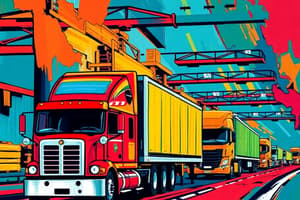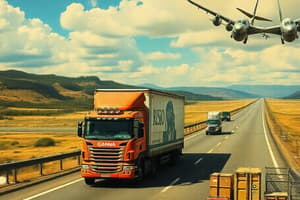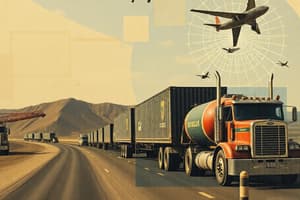Podcast
Questions and Answers
What does road transportation require to operate, similar to other businesses?
What does road transportation require to operate, similar to other businesses?
A supply of materials and facilities.
What are vehicles used for in road transportation?
What are vehicles used for in road transportation?
Carrying passengers through a route.
What is a route in the context of road transportation?
What is a route in the context of road transportation?
A path that has a starting point and endpoint where transportation operates.
What are the two main classifications of vehicle service types?
What are the two main classifications of vehicle service types?
What is non-fixed route passenger transportation?
What is non-fixed route passenger transportation?
Which of the following is an example of a collector/distributor?
Which of the following is an example of a collector/distributor?
Which kind of vehicles load and unload passengers at terminals usually located at the beginning and end of their route?
Which kind of vehicles load and unload passengers at terminals usually located at the beginning and end of their route?
What do stops serve as?
What do stops serve as?
Where are terminals located?
Where are terminals located?
What is the function of garages in road transportation?
What is the function of garages in road transportation?
What is a transit line?
What is a transit line?
What does ‘fleet’ refer to in road transportation?
What does ‘fleet’ refer to in road transportation?
What do passenger flow and volume measure?
What do passenger flow and volume measure?
What are the three basic operating elements in the process of transportation?
What are the three basic operating elements in the process of transportation?
What does line capacity refer to?
What does line capacity refer to?
What does frequency measure in road transport performance?
What does frequency measure in road transport performance?
What does dependability refer to in road transport service?
What does dependability refer to in road transport service?
What do safety and security measures refer to in transportation?
What do safety and security measures refer to in transportation?
What does capacity refer to in road transport?
What does capacity refer to in road transport?
What does utilization measure in transportation?
What does utilization measure in transportation?
What does service quality refer to in road transport?
What does service quality refer to in road transport?
What does environmental impact refer to in transportation?
What does environmental impact refer to in transportation?
What do intelligent transport systems refer to?
What do intelligent transport systems refer to?
The ____ barked.
The ____ barked.
Flashcards
Route
Route
A path with a starting point and endpoint where transportation operates.
Non-fixed Route Passenger Transportation
Non-fixed Route Passenger Transportation
Road transport without a fixed route or fare; fare depends on distance and service level.
Fixed Route Passenger Transportation
Fixed Route Passenger Transportation
Road transport with fixed routes and fares, following a regular schedule, often called 'mass transit'.
Stops
Stops
Signup and view all the flashcards
Terminals
Terminals
Signup and view all the flashcards
Garage (Transportation)
Garage (Transportation)
Signup and view all the flashcards
Transit Line
Transit Line
Signup and view all the flashcards
Fleet
Fleet
Signup and view all the flashcards
Passenger Flow and Volume
Passenger Flow and Volume
Signup and view all the flashcards
Object (Transportation)
Object (Transportation)
Signup and view all the flashcards
Distance (Transportation)
Distance (Transportation)
Signup and view all the flashcards
Time (Transportation)
Time (Transportation)
Signup and view all the flashcards
Line Capacity
Line Capacity
Signup and view all the flashcards
Frequency (Transportation)
Frequency (Transportation)
Signup and view all the flashcards
Dependability (Transportation)
Dependability (Transportation)
Signup and view all the flashcards
Safety and Security (Transportation)
Safety and Security (Transportation)
Signup and view all the flashcards
Capacity (Transportation)
Capacity (Transportation)
Signup and view all the flashcards
Passenger Expense
Passenger Expense
Signup and view all the flashcards
Utilization (Transportation)
Utilization (Transportation)
Signup and view all the flashcards
Intelligent Transport Systems
Intelligent Transport Systems
Signup and view all the flashcards
Study Notes
Basic Components of Road Transport
- Road transportation needs materials and facilities to operate just like other businesses
- Vehicles carry passengers through a route, which has a starting point and endpoint
Types of Passenger Transportation
- Non-fixed route transport doesn't have a fixed route or fare; the fare depends on distance and service level
- Fixed route transport has fixed routes and fares, follows a schedule, and is known as "mass transit"
Classifications of Mass Transit Service
- Collector/Distributor: Operates in local areas like residential or commercial districts, picking up and dropping off passengers along arterial roads
- Regular Service: Operates on main highways in urban areas with traffic restrictions, connecting major activity centers with designated stops
- Express Service: Operates on main highways and regional roads connecting provinces, loading and unloading passengers at terminals
Tourist Transportation Choices
- A tourist's choice depends on their travel style and purpose
- Some prefer mass transit, while traditional tourists opt for non-fixed routes for convenience
Stops
- Stops are locations for passengers to embark and disembark
- They can serve as transfer points and have signs with information
- Stops may include amenities like roofs, benches, and lighting to enhance convenience, with locations managed by the government
Terminals
- Terminals are located at the origin and destination points of a route
- They can serve as transfer points or be integrated to serve multiple routes in one location
- Terminal locations are assigned by the government and are larger than stops
- Regulations cover accessibility, traffic flow, and allowed areas in terminal construction
Garages
- Garages are located away from main roads, storing vehicles when not in use
- They are also used for vehicle maintenance and repairs
Basic Components of Road Transport Operation
- Transit line is the infrastructure for transport service, aligned for vehicles operating on a schedule
- Transit network is a coordinated set of transit lines for efficient operation and integration
Fleet
- Fleet refers to the vehicles used for regular passenger service
- Fleet size is the number of vehicles needed
- A transit unit is a group of vehicles from a fleet traveling together
- A fleet may have one type of vehicle or different models to adapt to passenger demand, with inspections for compliance with standards
Passenger Flow and Volume
- Road transportation depends on travel demand
- Passenger flow is the rate of passenger travel, while passenger volume is the number of passengers in a specific period
Operating Elements
- Object: Persons, goods, and units being delivered
- Distance: Area covered by the trip
- Time: Time taken to complete the trip
Line Capacity
- Line capacity is the number of transit units in a line within a timeframe, factoring in weather, population density, and road pavement condition
Road Transport Performance Indicators
- Frequency: Number of vehicles dispatched per time, measuring reliability and passenger satisfaction
- Dependability: Availability of transport service, measured by adherence to schedule and waiting times
- Safety and Security: Vulnerability of passengers to risk or harm, measured by vehicle features, operation, and transport facility conditions
- Capacity: Maximum number of passengers and distance covered, measured by space, seats, and distance
- Passenger Expense: Passenger cost, measured by reasonability and affordability
- Utilization: How often the service is used, measured by passenger occupancy and distance
- Service Quality: Passenger satisfaction, measured by comfort, convenience, cleanliness, crew attitudes, and amenities
- Environmental Impact: Effects on air quality, noise, traffic, and long-term impacts like land degradation and corrosion
Intelligent Transport Systems
- Intelligent transport systems use systems that make it easier for passengers to transact and avail of services
- Examples: Automated fare collection, dashcams and surveillance cameras
Rail Transport Management
- Rail transport shares similarities with road transport, using the same basic components like networks, fleet (rolling stock), passenger flow, operating elements, and capacity
Basic Train Services and Design Principles
- Designing rail transport relies on clarifying what service the transport provides to passengers. The process takes place on three levels
- Strategic level: Meeting long-term goals with infrastructure and rolling stock investment decisions
- Tactical level: Achieving mid-term goals with planned service types, timetables, and staff operations
- Operational level: Achieving short-term goals, with shifting personnel and determined tasks in day-to-day operations, equipment failures and accidents are being dealt with
Types of rail transportation services
- Urban service: Tramways, metro rails, and monorails
- Suburban service: Commuter rails powered by locomotives
- Regional service: High-speed or tilting trains for interregional trips
- International service: Same type of trains as regional service
- Miscellaneous services: Airport links, tramways for tours, and heritage trains
Parameters for Designing Railway Services
- Type of service offered to passengers
- Timetable of service
- Origin and destination of terminals/stations, including main terminals
- Departure/arrival times of trains in terminals/stops
- Frequency of the service
- Type of rolling stock to be used
- Commercial considerations like fare structure and boarding process
Scheduling of Passenger Railway Service
- Travel times between stations should be determined to set timetables
- Most railway systems use regular time intervals
- The Philippine National Railways (PNR) uses a 40-minute interval
- Adjusting time intervals is common based on time and demand to reduce costs
- Developed systems should consider other interconnected railway systems
Considerations for Interconnected Railway Systems
- Main transport corridors must be determined
- One system should correspond with another's operating schedule
- Interconnections and transfers should have feasible destinations
- Constant service should be provided
- Train routes/itineraries should be announced
Rolling Stock Selection
- Selecting the right rolling stock is based on the needs of passengers
- Consider the factors in the procurement of the right rolling stocks:
- Useful lifespan (30-35 years including repairs and maintenance)
- The development of the right railway infrastructure
- Type of services provided
Procurement Considerations:
- Take advantage of innovations
- Increase service quality and adapt to change
- Cover shortages and replace defective units
- Take advantage of infrastructure possibilities
- Increase competitiveness against other transport
- Respond to unmet needs
- Increase safety
Quality Parameters of Rail Transportation
- Shorter and competitive travel time
- Reliability and regularity
- Service frequency
- Relatively low and competitive fares
- Comfort
- Security
- Easy Ticketing
- Special Services
Fundamentals of a Successful Land Transport
- Success depends on the passenger experience
- Optimize of passenger experience when using land transportation determines if the system is a success or failure
Density Considerations
- Focus on high-density areas for land transport
- Increase population in areas where land transport is available (transit-oriented development)
Activity Factors
- Serve routes to major employment and activity centers
- Connect activity centers for various needs and purposes
Walkability
- Prioritize pedestrian-friendly pathways to terminals and stops
- Improve pathways toward terminals and stops
- Create a pedestrian environment
- Turn front doors to pedestrians
Connectivity
- Use networks to connect routes, considering geography and activity centers
- Build hubs for interacting routes to provide easy access and information
- Unify fares within a network for seamless transfers
Schedule
- Provide all-day frequent service, considering the following factors:
- Vehicle capacity
- Operating costs
- Time of day and passenger density
Travel Time
- Focus on destinations reached instead of distance covered
- Optimize trip time by balancing all phases of the trip (walking, waiting, riding, etc.)
- Establish express services as a parallel with fewer stops
Reliability
- Achieve a dependable system
- Minimize unreliability caused by traffic by creating dedicated lanes and adjusting traffic light signals
- Minimize unreliability of the boarding process, through an improved boarding process:
- Off-board fare collection
- All-door boarding
- Level boarding for easy access
- Service culture to handle delays properly
Capacity
- Transport passengers with a high capacity to meet demands
Legibility
- Passengers are more inclined to use transport methods they understand
- Create a brand for the network to give it an identity
- Identify lines to distinguish routes with colors, numbers, or names
- Identify frequency to denote how often service is availible
- Identify stops and destinations
- Clarify transfers to assist passengers
- Simplify networks so that passengers can remember more easily
- Create a legible experience by following all aspects of legibility
Studying That Suits You
Use AI to generate personalized quizzes and flashcards to suit your learning preferences.




